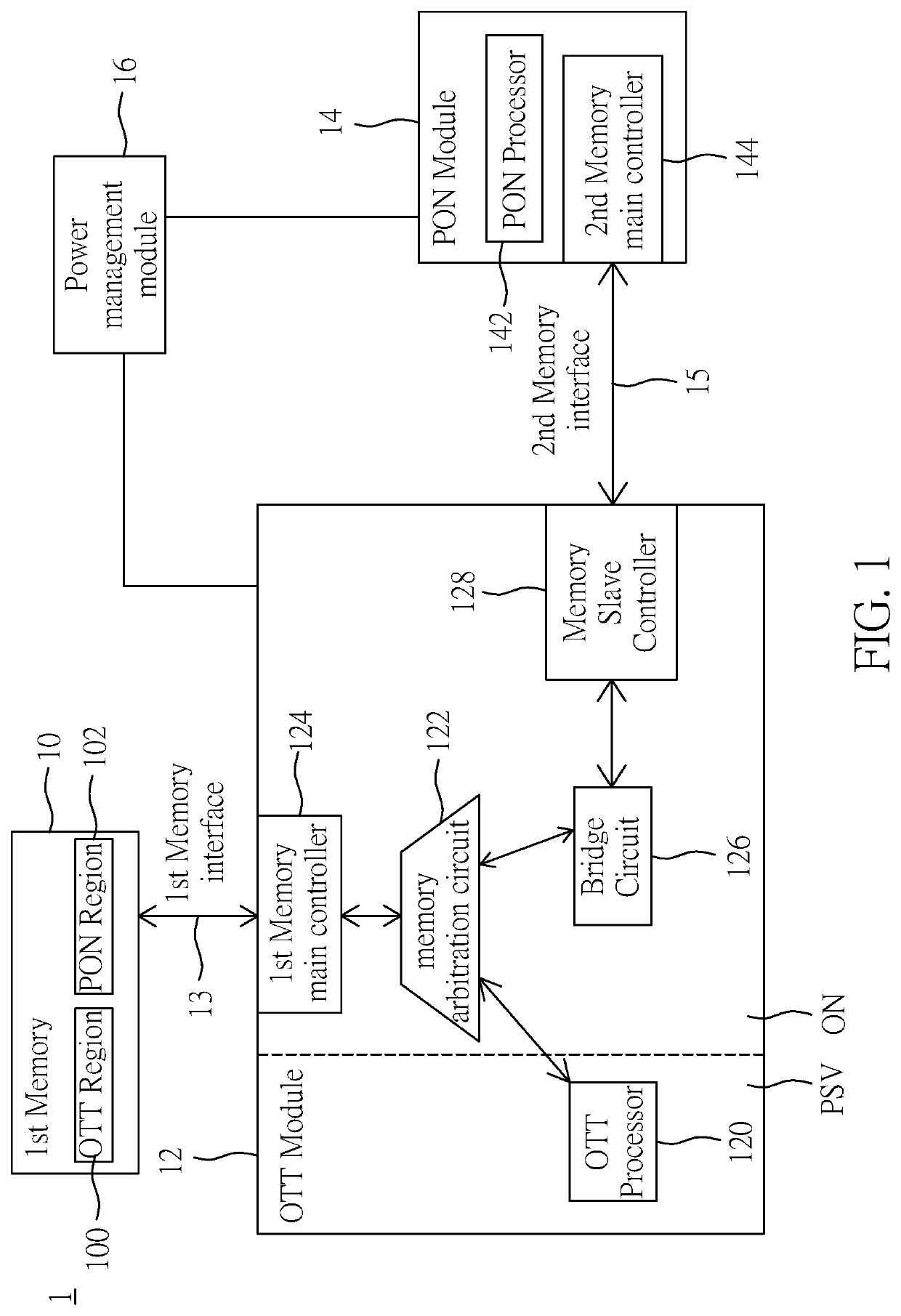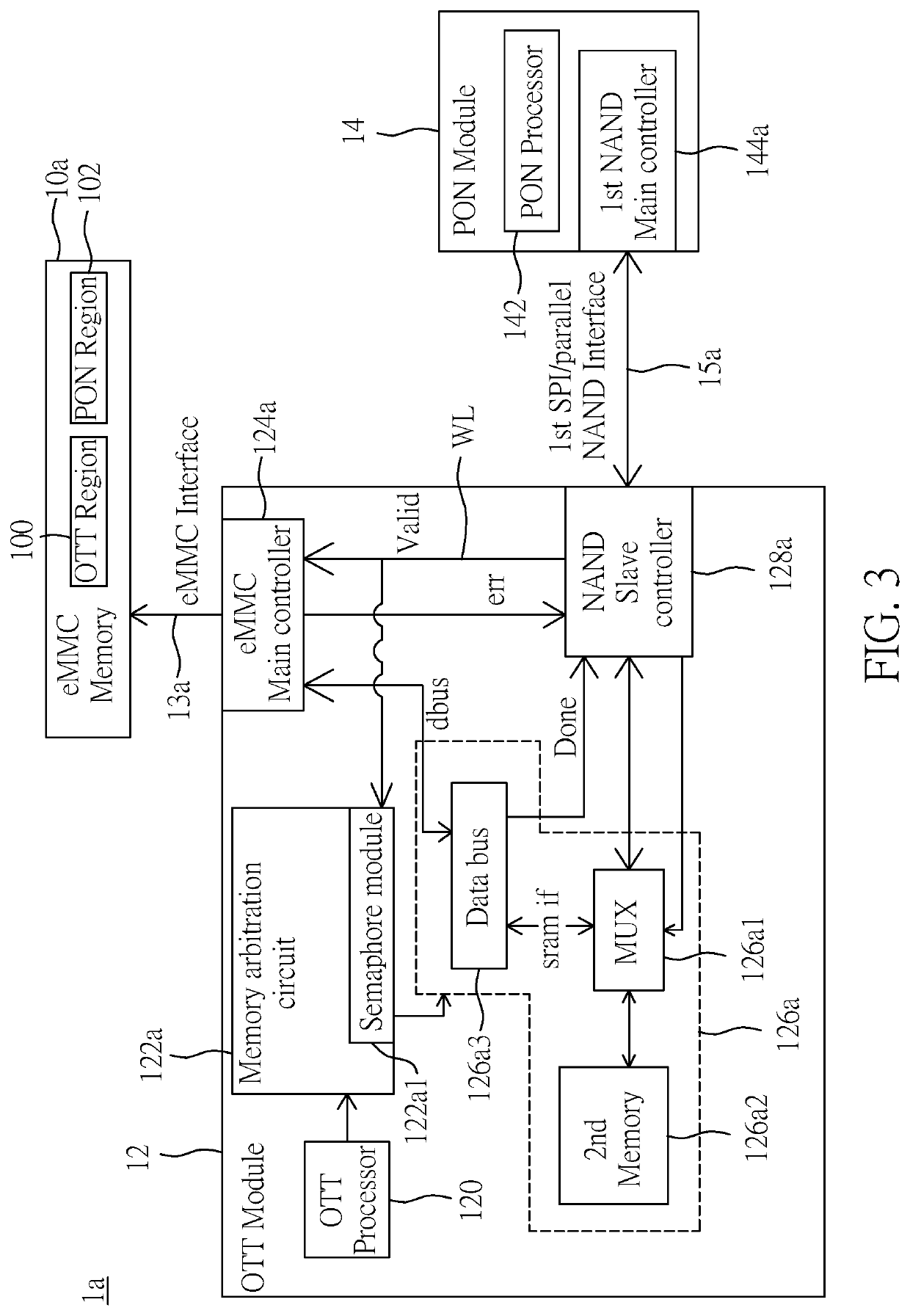Memory sharing dual-mode network communication device
a network communication and memory technology, applied in the direction of instruments, input/output carriers, climate sustainability, etc., can solve the problems of inability to use the pon device, incompatibility of the flash memory control chip available, and difficulty in achieving the same speed with conventional flash memory control chips
- Summary
- Abstract
- Description
- Claims
- Application Information
AI Technical Summary
Benefits of technology
Problems solved by technology
Method used
Image
Examples
first embodiment
[0022]Reference is made to FIG. 1, which is a block diagram of a memory sharing dual-mode network communication device according to a first embodiment of the present disclosure. The first embodiment of the present disclosure provides a memory sharing dual-mode network communication device 1, which includes a first memory 10, an OTT module 12, a PON module 14, and a power management module 16. The first memory 10 is divided into an over-the-top (OTT) region 100 and a passive optical network (PON) region 102 for being used by the OTT module 12 and the PON module 14, respectively. The OTT module 12 can be used in a TV set box or an OTT TV box to connect with a cloud server to obtain an OTT service, so that a user can watch a digital TV program. On the other hand, the passive optical network (PON) module 10 can be used to provide optical fiber communication networks to users. For the most fiber-to-the-home technology that is currently being noticed by telecom operators, the advantage li...
second embodiment
[0032]Reference is made to FIG. 2, which is a block diagram of a memory sharing dual-mode network communication device according to a second embodiment of the present disclosure. The second embodiment of the present application provides a memory sharing dual-mode network communication device 1a, which includes an eMMC memory 10a, an OTT module 12, and a PON module 14. In the present embodiment, like elements are denoted by like reference numerals and will not be described again. The OTT module 12 includes an OTT processor 120, a memory arbitration circuit 122, an eMMC main controller 124a, an NAND / eMMC bridge circuit 126a, and a NAND slave controller 128a. The memory arbitration circuit 122 is coupled to the OTT processor 120, and the eMMC main controller 124a is coupled to the memory arbitration circuit 122 and coupled to the eMMC memory 10a via an eMMC interface 13. The NAND / eMMC bridge circuit 126a is coupled to the memory arbitration circuit 122, and the NAND slave controller 12...
third embodiment
[0047]Reference is made to FIG. 4, which is a block diagram of a memory sharing dual-mode network communication device according to a third embodiment of the present disclosure. The third embodiment of the present disclosure provides a memory sharing dual-mode network communication device 1b, which includes an MLC NAND memory 10b, an OTT module 12, and a PON module 14. In the present embodiment, like elements are denoted by like reference numerals and will not be described again. The OTT module 12 includes an OTT processor 120, a memory arbitration circuit 122, a second NAND main controller 124b, a bypass bridge circuit 126b, and a NAND slave controller 128a. The memory arbitration circuit 122 is coupled to the OTT processor 120. The second NAND controller 124b is coupled to the memory arbitration circuit 122 and coupled to the MLC NAND memory 10b via the second SPI / parallel NAND interface 13b. The bypass bridge circuit 126b is coupled to the memory arbitration circuit 122, and the ...
PUM
 Login to View More
Login to View More Abstract
Description
Claims
Application Information
 Login to View More
Login to View More - R&D
- Intellectual Property
- Life Sciences
- Materials
- Tech Scout
- Unparalleled Data Quality
- Higher Quality Content
- 60% Fewer Hallucinations
Browse by: Latest US Patents, China's latest patents, Technical Efficacy Thesaurus, Application Domain, Technology Topic, Popular Technical Reports.
© 2025 PatSnap. All rights reserved.Legal|Privacy policy|Modern Slavery Act Transparency Statement|Sitemap|About US| Contact US: help@patsnap.com



